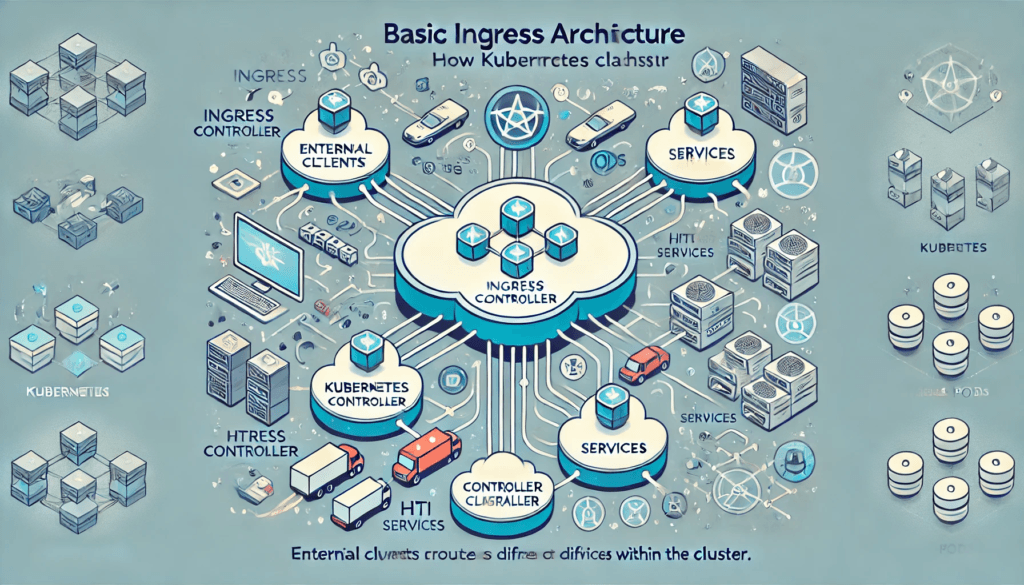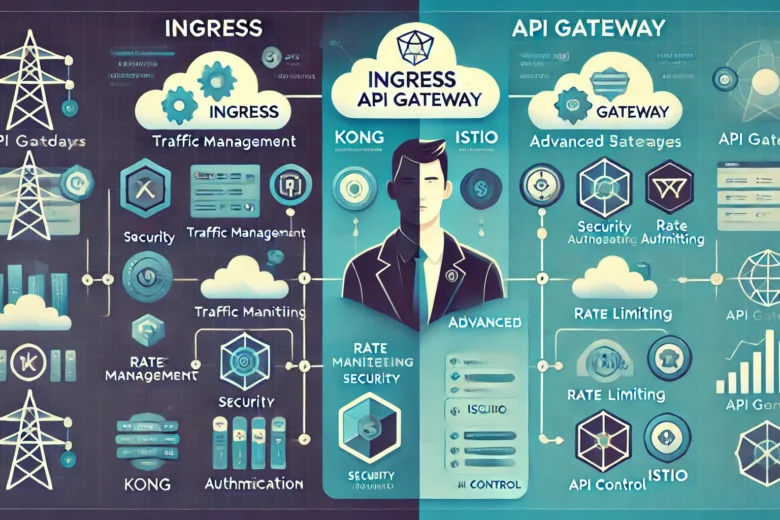TL;DR: Kubernetes is evolving beyond the use of Ingress to expose services. As microservices and API-driven applications grow in complexity, many organizations are migrating to API Gateways for more advanced traffic management, security, and API control. API Gateways like Kong, Ambassador, and Istio offer features such as rate limiting, authentication, analytics, and more, which are not provided by Ingress. This guide explores why and how to transition from Ingress to API Gateway in your Kubernetes environment.
Transitioning from Ingress to API Gateway in Kubernetes: The New Standard for Exposing Services
As Kubernetes adoption continues to surge, the ways in which services are exposed to external traffic have evolved significantly. Initially, Ingress was the primary solution for routing HTTP and HTTPS traffic into Kubernetes clusters. However, with the increasing complexity of microservices and API-driven architectures, API Gateways are emerging as the new standard for handling traffic, offering advanced features like authentication, rate limiting, and comprehensive API management.
In this article, we’ll explore the shift from Ingress to API Gateway in Kubernetes, discuss why this transition is gaining momentum, and provide guidance on how to adopt API Gateways to better expose services in your Kubernetes environments.
What is Ingress in Kubernetes?
Ingress in Kubernetes is a resource that manages external access to services within a cluster. It defines rules for routing traffic (usually HTTP or HTTPS) to services based on their paths, domains, or ports. Ingress controllers, such as NGINX or Traefik, are responsible for managing the flow of traffic and applying Ingress configurations.
While Ingress is a reliable way to expose services in Kubernetes, it has limitations when it comes to advanced API management, security, and traffic control. As applications and services scale, Ingress often struggles to provide the level of granularity and control required by modern, API-driven microservice architectures.
Image Suggestion: Diagram illustrating basic Ingress architecture and how traffic flows into a Kubernetes cluster.
The Rise of API Gateway in Kubernetes
The concept of an API Gateway is not new but has recently gained popularity within Kubernetes environments due to its ability to manage and secure traffic in ways that Ingress cannot. An API Gateway acts as a central entry point for all incoming traffic and provides features beyond simple traffic routing, such as API authentication, rate limiting, traffic analytics, and load balancing.
With Kubernetes becoming the go-to platform for running microservices, API Gateways like Kong, Ambassador, and Istio are being widely adopted. These tools go beyond the basic routing capabilities of Ingress by providing API management, security policies, and traffic control, making them essential for complex microservices environments.
API Gateways are designed to handle more advanced use cases compared to Ingress. They can enforce consistent security policies across all services, offer detailed usage analytics, and help manage service dependencies effectively. This level of functionality makes them a powerful tool for modern cloud-native applications that require greater resilience, security, and performance.

Why Are Kubernetes Deployments Moving From Ingress to API Gateway?
As Kubernetes environments become more complex, the limitations of Ingress are becoming more apparent. Below are the key reasons why organizations are increasingly choosing API Gateways over Ingress for service exposure:
1. Advanced Traffic Management
API Gateways offer much more than basic routing; they can handle complex traffic routing, load balancing, and traffic splitting for canary deployments or A/B testing. API Gateways also enable circuit breaking, ensuring that services don’t get overwhelmed by traffic surges. These capabilities are essential for managing microservices that need to scale dynamically and operate reliably under varying loads.
2. Enhanced Security and Authentication
While Ingress supports TLS termination, it lacks native support for more advanced security mechanisms. API Gateways integrate seamlessly with modern security standards like OAuth2, JWT (JSON Web Tokens), and API key management. This is crucial for securing microservices at scale. With API Gateways, developers can enforce granular access control, apply DDoS protection, and implement end-to-end encryption without the need for extensive manual configurations.
3. API Management
An API Gateway provides full-fledged API management features, such as version control, rate limiting, and analytics. This allows you to monitor and control your API usage across multiple services and environments, ensuring that your APIs are always performing optimally. The observability that API Gateways provide also helps DevOps teams gain deeper insights into service usage patterns, enabling them to optimize performance and troubleshoot issues more efficiently.
4. Flexibility and Scalability
Unlike Ingress, which was primarily designed for HTTP/HTTPS traffic, API Gateways can handle multiple protocols and more complex routing rules. This makes them a better fit for polyglot microservices environments, where different services might require different protocols or custom routing. API Gateways can also integrate with service meshes, providing additional features like mutual TLS (mTLS), traffic shadowing, and failover strategies, which are crucial for maintaining high availability and fault tolerance in large-scale systems.
Key Features of API Gateways for Kubernetes
API Gateways offer a variety of advanced features that make them an attractive alternative to Ingress for modern Kubernetes environments:
- Traffic Management: API Gateways provide advanced load balancing, traffic shaping, and rate limiting to help manage workloads efficiently. Features like blue-green deployments and canary releases ensure that new features are deployed with minimal risk.
- Security: Built-in support for OAuth2, JWT authentication, and DDoS protection ensures that your services are protected from common attack vectors. Additionally, API Gateways offer token validation, IP whitelisting, and WAF (Web Application Firewall) capabilities to further enhance security.
- Observability: Gateways offer detailed analytics and metrics, helping teams understand how their services are used and monitor performance. Integration with tools like Prometheus and Grafana provides real-time visibility into service health and traffic patterns.
- Service Discovery: Automatic service discovery allows Gateways to integrate seamlessly with microservices architectures, automatically detecting and configuring new services. This feature significantly reduces the manual effort required to manage and update service configurations.
How to Migrate from Ingress to API Gateway
Migrating from Ingress to an API Gateway involves careful planning and execution. Below, we outline the steps you can follow to make the transition smoothly.
Step 1: Assessing Your Current Ingress Setup
The first step in the migration process is to assess your current Ingress configuration. This involves reviewing all the Ingress resources, the services they route to, and any specific rules or annotations being used. This assessment will help you determine the requirements for your new API Gateway.
Step 2: Choosing the Right API Gateway for Kubernetes
Selecting the appropriate API Gateway is crucial. Here are some popular options:
- Kong Gateway: Known for its ease of use and powerful plugin system. It provides features like dynamic routing, caching, and health checks.
- Ambassador: Designed specifically for Kubernetes, offering great integration and developer-friendly features. Ambassador supports gRPC, WebSockets, and integrates seamlessly with Edge Stack for additional functionality.
- Istio: A service mesh that also includes API Gateway functionality, suitable for advanced use cases involving observability, security, and traffic management.
Step 3: Setting Up an API Gateway in Kubernetes
Once you have chosen the API Gateway, the next step is to deploy it within your Kubernetes cluster. Each API Gateway has its own setup process, but typically this involves deploying a set of services and configuring the Gateway to expose your existing microservices.
- Deploying Kong: Use Helm charts to easily deploy Kong within your cluster. Helm simplifies the installation process and provides flexibility for configuration adjustments.
- Configuring Routes and Services: Define routes, services, and any necessary plugins for features like rate limiting or authentication. With Kong, you can use declarative configuration files to manage routes, making it easier to automate the setup and ensure consistency across environments.

Real-World Examples of API Gateway Usage in Kubernetes
Company A transitioned from Ingress to Kong Gateway for its microservices architecture. This migration allowed the company to implement rate limiting, API analytics, and OAuth2-based authentication, significantly improving the security and scalability of their services. The ability to enforce security policies at a central entry point helped reduce vulnerabilities and ensured consistent access controls across all microservices.
Company B opted for Ambassador as their API Gateway, due to its close integration with Kubernetes. The migration improved their ability to split traffic for canary releases, helping them deploy new features more confidently. By leveraging Ambassador’s developer-friendly interface, Company B was able to accelerate deployments and enhance the reliability of their services.
Company C used Istio as an API Gateway and service mesh to manage their Kubernetes environment. Istio’s observability and telemetry capabilities allowed the company to gain real-time insights into the performance and security of their services. They were also able to implement mTLS to secure communications between services, enhancing their security posture.
Conclusion
Kubernetes is evolving, and the shift from Ingress to API Gateways reflects the changing needs of modern cloud environments. API Gateways offer advanced traffic management, security, and API control that go beyond what Ingress can provide, making them the preferred choice for complex microservices and API-driven applications.
If you’re planning to migrate from Ingress to an API Gateway, start by evaluating your current setup and requirements, then choose a Gateway that aligns with your needs. By adopting API Gateways, you gain greater control over how your services are exposed and secured, helping you to scale your architecture effectively.
API Gateways are not just about routing traffic—they are about managing and securing access to services at scale. With features like rate limiting, authentication, and traffic monitoring, they provide a comprehensive solution for managing microservices in Kubernetes. Whether you are building a new system or enhancing an existing one, adopting an API Gateway can help you future-proof your infrastructure for the evolving demands of cloud-native applications.



